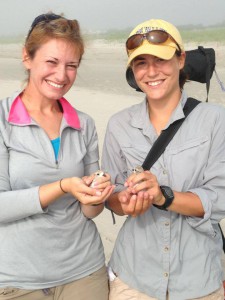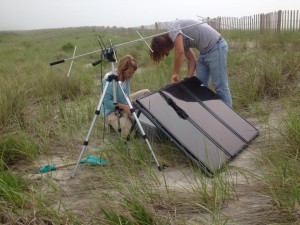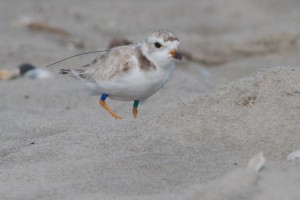Overview of piping plover flight behavior research
CWF alumni guest blog
By Emily Heiser, Piping Plover Research Technician

Call me crazy, but the combination of piping plovers and New Jersey are just too much for me to resist! Over the last six years, I have spent the majority of my time working for Conserve Wildlife Foundation of New Jersey and New Jersey Division of Fish and Wildlife protecting piping plovers on their nesting grounds. Most recently I worked on a research project with the State University of New York-ESF that dealt with piping plover flight behavior in Stone Harbor, Avalon and Strathmere, New Jersey. The project’s graduate student, Michelle Avis conducted the other half of the study on Cape Cod, Massachusetts. The project was specifically designed to look at piping plover flight patterns across their breeding grounds. The results of the study could have implications for the management of coastal wind turbine development.
One of the major components of this project was our ability to track individual birds throughout their breeding seasons. Alongside my

(Photo courtesy of Lauren Gingerella)
awesome sidekicks, Christy Weaver (2012) and Lauren Gingerella (2013), we color banded 54 piping plovers between three nesting sites in Cape May County. Each female from a nest was also fitted with a radio transmitter. The transmitters were attached to their backs and the birds typically carried them for six to eight weeks. The transmitters allowed us to efficiently track birds and collect data on the range of daily movements, foraging territories and whether or not the birds fly in poor weather conditions. With the assistance of an automated telemetry receiver we were also able to track the birds 24/7 in various types of weather conditions. We lovingly named our receiver, R2D2. R2D2 hit the beaches of Stone Harbor, Avalon and Strathmere most of the summer. He helped us keep track of our birds when we couldn’t be there.

(Photo courtesy of Tom Reed)
Considering that the project had so many different aspects, it’s safe to say that we had the most fun we could have. We worked closely with the monitors from CWFNJ and NJDFW each season. One of the highlights of the field season for everyone was being up close and personal with the birds everyday. In addition to the huge volume of data we collected, which are still to be analyzed, many useful, anecdotal observations can be attributed to those little color bands. I think we are all looking forward to seeing where everyone ends up as they begin their migration south for another season. I hope I’m here to greet them on their return next year!
The overwhelming support from everyone at CWFNJ and NJDFW was outstanding and contributed immensely to the overall success of the project in New Jersey. I have a lot of love for New Jersey and the plovers that call it home.
Discover more from Conserve Wildlife Foundation of NJ
Subscribe to get the latest posts sent to your email.